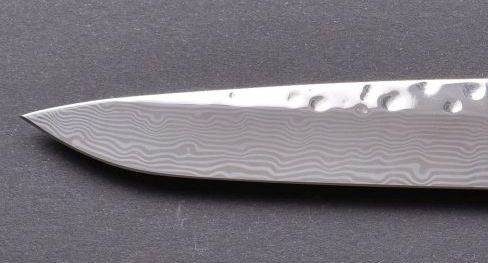Mcusta Asanoha

For understandable reasons, 2020 cannot be described as a great year. But there are also facts that we are rightly very proud of. One of them is the award of the Nippon Knives e-shop by Marusho Industry Inc., which supplies Zanmai and Mcusta knives to the Slovak market through our company. For this purpose, a single copy of the Mcusta knife was made, specifically for the Nippon Knives. The decision was made on a compact knife with a fixed blade. Its essence is hidden in the seemingly complicated name MCUSTA Limited Edition Urushi Art model "Asanoha". The typical sense of practicality for the Japanese is to include the product's features in its name, and this case only confirms this.

At the Mcusta brand, we are used to working only with premium materials. It is no different now. The basis of the construction is a coreless plate made of 30 layers of first-class steels VG-10 and VG-1. So Damascene is not only a blade, but also a skeleton handle. If on the side of the blade the steel is straight with a gentle hand beating at its uppermost part, the one forming the skeleton of the handle is beautifully profiled. The thicker and thinner segments alternate here, which give the knife a dynamic accent. Let's add a mention of hamaguri blades and we can start focusing on the main one. & Nbsp;
You've probably met Urushi or Japanese lacquer. It is a traditional way of decorating jewelry and other small items such as cassettes, pens, jewelry boxes and the like. It has been used in Japan since the 7th century. The artists cover their drawings or marquetry with varnish obtained from the pulp of the Urushi tree. The shapes are created by painting, inserting mother-of-pearl, or the maki-e technique, in which pieces of gold or silver are "sprayed" onto the urushi-pulp substrate with the help of a bamboo tube. There are several maki-e techniques that differ in the number of layers. The result is multidimensional decorative paintings.

Urushi Art is very popular in Japan. However, it requires a great deal of skill and patience. After all, the production of a small pearl piece of jewelry takes the artist up to 26 days. A highly respected entity in the field of Urushi Art is the family company Hariya, which has been dedicated to this art since 1981. And it was this company that was invited to cooperate in the production of this knife, as evidenced by its name engraved on the blade.

In addition to the Damascene coreless material, the handle is made of wood from Japanese persimmon. Artists from Hariya applied the traditional Asanoha pattern made of 24 carat gold to it. Very often you will find it on Japanese kimono, but also on modern design products. They inserted more or less significant colored dots in the middle of the individual flowers. When moving in the light, a projection of colored lights resembling LEDs takes place. Understanding how such perfection can be achieved by hand is beyond our imagination.
The knife is, of course, packed in a box made of paulownia wood / kirbako /. The attached certificate confirms the production of a single piece, exclusively for Nippon Knives. In this case, it is completely useless to talk about a price that, by the way, commemorates the date of the Great French Revolution. This is far from an adequate reflection of the value of this exceptional product.
See more pictures tu.


 Sign in
Sign in Registration
Registration



























